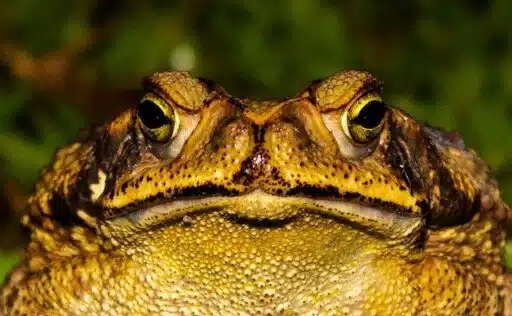Have these clumsy green crawling creatures ever caught your attention? Do you often stop what you are doing to look at the frog-like species that hop across your path? You are not alone if you adore these tiny green creatures with big beady eyes. Although many are fascinated by these amphibians, how much do we really know about them? After reading this article, you’ll know a little more. We will uncover what toads eat.
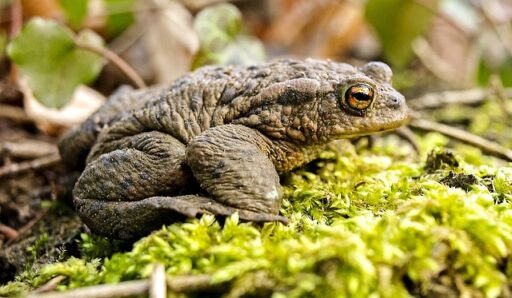
The green amphibians with dry and warty skin are known as toads. They prefer open and moist habitats like grasslands and fields. Toads go through a complete life cycle, requiring special care and a different diet at each stage.
Many frog lovers and pet owners are interested in taking care of toads and learning about their appetites. Therefore, we bring you a detailed post covering everything related to the toad’s diet. We will give you the best ideas, practical tips, and mistakes to avoid while feeding these living beings.
Read on to learn what type of food your toads need to grow and thrive in a healthy environment.
Toads vs Frogs
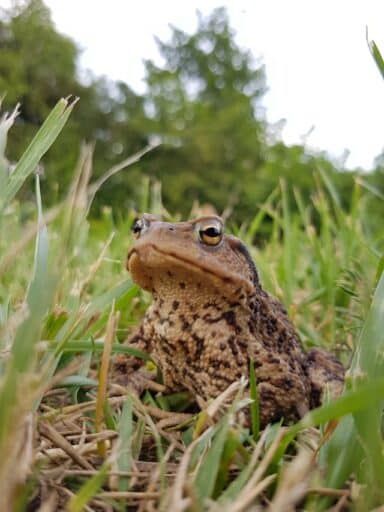
Toads are often mistaken for frogs due to the strong similarity of physical characteristics and resemblance in features. Without knowledge, many people get confused and consider them the same since both have four legs with no tail.
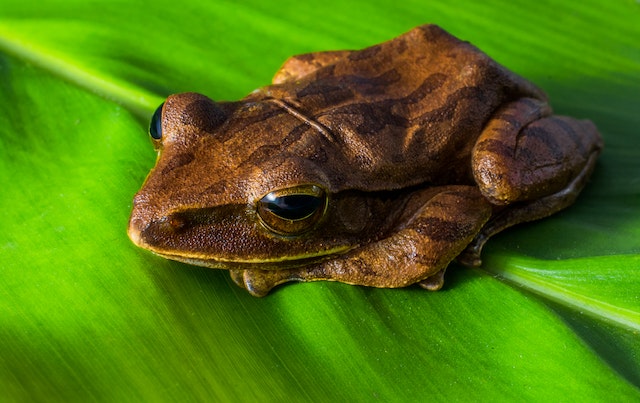
You might ask whether there really is any difference between the two. How can we distinguish toads from frogs?
To differentiate between toads and frogs, make sure you note the following characteristics:
- Toads have rough, leathery, and warty skin.
- Toads have shorter legs than frogs.
- Toads don’t jump like frogs; instead, they crawl.
- Toads have uneven heads, unlike the angular and shaped heads of frogs.
- Toads spend the most time on land, being more terrestrial than frogs.
- Toads don’t have a dark patch behind their eyes like frogs.
- Toads lay their eggs in water in the form of a long spawn string, instead of a clump as frogs do.
Despite the basic similarities, the above list confirms that toads are not the same as frogs. Therefore, the next time you come across these species, you can easily differentiate between the two.
How Do Toads Hunt for Food on Land?
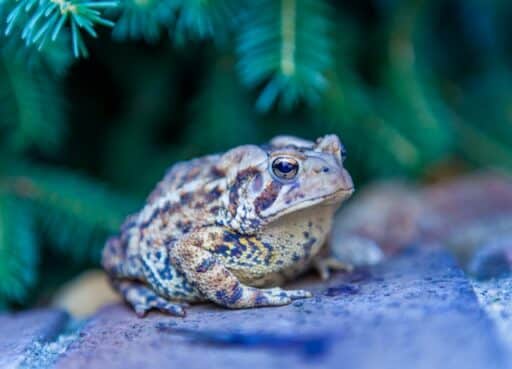
Food is undoubtedly one of the basic necessities of life. Every living being depends upon food for survival. Similarly, toads need food to perform their activities and grow strong.
Surely you’ve pondered how toads generally attain food without any human assistance. Toads are gifted with sharp eyesight and an exceptional sense of smell by nature, and they use these senses to search for food.
One of the biggest strengths of a toad is the keen sight that helps it reach its food. Its excellent vision helps it locate food by spotting colors at night in deep darkness. They can easily find their moving prey using their sight.
Other than this outstanding feature, toads possess a powerful sense of smell. However, research shows that toads hardly rely on their sense of smell for searching food, but rather they use it to mark out territories.
Toads also have a strong sense of taste that they use to reject food they don’t like. Furthermore, they have a keen sense of touch, although they normally don’t use touch or taste to find food.
Common Hunting Styles of Toads
Different toads employ different hunting styles according to their natural traits to get their food. The majority of toads become active at night to search for food when other insects come out.
Toads crawl or run to cover distances. Some of the toads prefer chasing their prey, while another species, Natterjack toads, get hold of their prey by running after them and roping them with their long sticky tongues.
Another category of toads burrow themselves in the ground and wait for the prey to come near. After the prey comes within proximity, toads jump up to grasp them.
Some toads use their tongues to capture the prey, whereas the others who don’t have this trait simply walk to the prey, jump on them, and swallow them at once.
What Are Tadpoles?
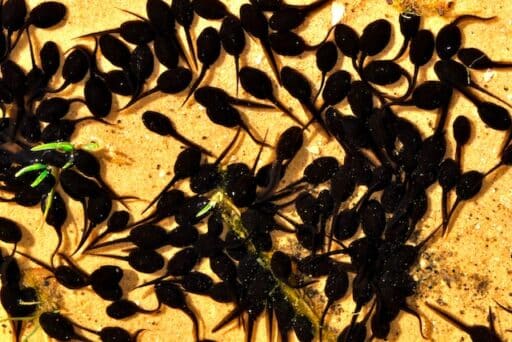
Toads go through a complete life cycle, starting from a tadpole, growing into a juvenile, and finally becoming an adult. Their diet, food preferences, and feeding patterns change at each stage.
Tadpoles are small immature forms of frogs that start their life inside an egg sack. They grow in large clumps or strings of eggs with thousands of other fellow tadpoles.
In the Initial phase, they are not fully carnivorous. Their air-breathing lungs are underdeveloped, and they are confined within the pond or lake where they are born. At this stage, they are entirely aquatic creatures.
Tadpoles’ Diet
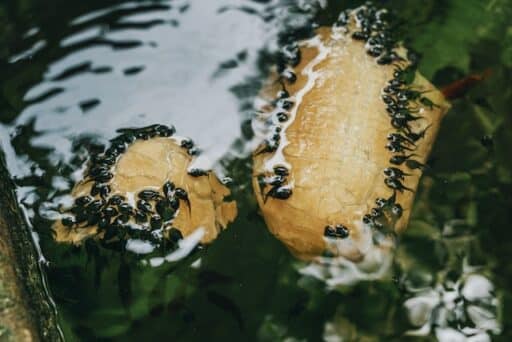
Tadpoles eat the yolk inside their egg sack as the first source of food. When they grow large enough, they hatch in water. This can take two to four days, depending on the weather conditions and the species’ nature.
After they hatch, they eat the remaining yolk in their egg sack. They swim around to find more sources of nutrition.
After finishing the yolk, tadpoles shift to aquatic vegetation like algae, moss, and decaying plant matter. They are omnivorous and eat small fish, insects, and phytoplankton.
Tadpoles mostly target fruit flies, insect larvae, and small worms.
Some tadpoles tend to become cannibalistic, and sometimes they engage in cannibalism and consume other tadpoles in order to survive. Cannibalistic tadpoles are rare in existence as they only appear to cope with the shortage of aquatic vegetation.
If the supply of aquatic vegetation is sufficient, cannibalistic tadpoles are nothing to worry about.
What Is the Diet of Juvenile Toads?
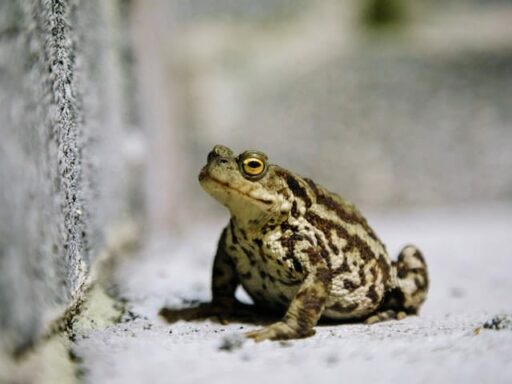
After the tails disappear and the legs begin forming, the tadpoles turn into juvenile toads. Their tail is also a source of nourishment. At this stage, juvenile toads become carnivorous and survive on small insects as they can’t chew food properly.
For dietary fulfillment, juvenile toads must be fed four to six small earthworms, grain moths, leaf rollers, or mealworms.
As they swallow food whole, Juvenile toads can’t eat large prey such as rodents due to the risk of choking.
With growth, the appetite and food range of Juvenile toads increases before eventually becoming adults. As they grow bigger, they are able to swallow larger animals like:
- Flies, such as mosquitos
- Small moths
- Ants
- Fruit flies
- Pinhead Crickets
- Small invertebrates
What Do Adult Toads Like To Eat?
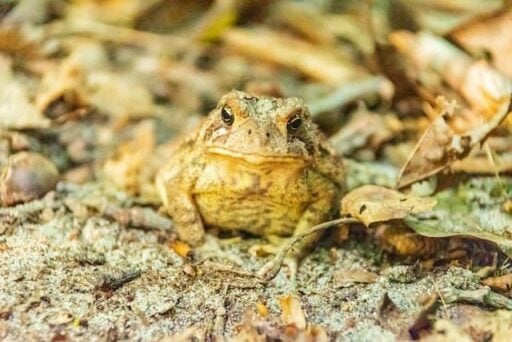
Adult toads eat almost anything they can swallow easily. They are not picky eaters and eat reptiles, insects, and small mammals that are commonly found around their typical habitat.
Adult toads tend to eat the following items on the list:
- Grubs
- Slugs
- Snails
- Mice
- Lizards
- Snakes
- Small Fish
- Other toads and frogs
Large toads are known for eating small mammals such as mice, small lizards, and sometimes snakes.
Ideally, adult toads should be given six wax worms, super worms, or crickets to eat every two days.
Always try to be very careful about the size of food you add to their diet and assess what they can swallow. Toads that are larger in size can have a broader range of foods.
Due to their diverse diet, they tend to eat both useful and harmful garden insects. Overall, they have a positive impact the gardens they inhabit.
What Do the Toads Prefer To Eat in the Wild?
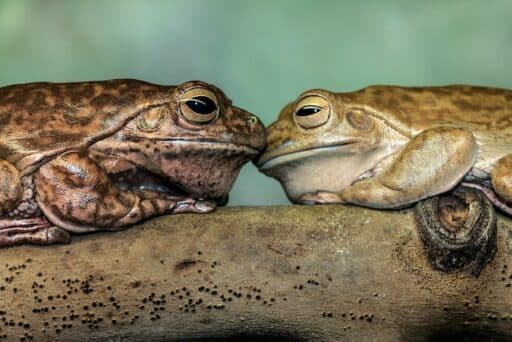
Toads belong to the carnivore group and survive by capturing and eating live prey. Like humans, toads require a perfectly balanced diet.
Toads eat a wide variety of foods. Normally they consume four to six spiders, worms, or crickets every few days.
Toads are generally small, and they don’t grow more than 4 or 5 inches in length. Because of their size, they can’t eat large living creatures.
Generally, you can observe that the larger the toad, the bigger its food chain will be. Larger toad species, such as cane toads, can devour rodents.
Each toad species has differences, but their dietary needs are the same. Adult toads like to eat the following items:
- Bugs
- Centipedes
- Flies
- Weevils
- Crickets
- Grasshoppers
- Mealworms
- Locusts
- Snails
- Slugs
- Aquatic animals
Adult toads don’t fear the risk of choking, so they have a much wider range of food options. Juveniles are comparatively smaller than adults, and consequently, they eat pinhead crickets, ants, and flies.
The tadpoles in the wild eat remains of dead bugs or worms and decomposed leaves falling into ponds, streams, or lakes.
It is important to remember that wild toads eat what they find in their surroundings, subject to availability. For instance, a toad living in South America will have different food options than one native to Africa.
It’s because the native insects of different regions vary worldwide. Despite this fact, toads eat more or less the same types of food around the globe.
The toads living in gardens satisfy their hunger whenever they spot prey. But toads in the wild have no certainty of meals. They never know when they will get something to eat next. Therefore, they lack appetite control and eat until all available prey in the locality is eaten.
Wild toad species eat live prey as dead insects and animals could potentially carry disease.
Learn what happens to toads when they eat beetles.
What Is the Diet of Pet Toads?
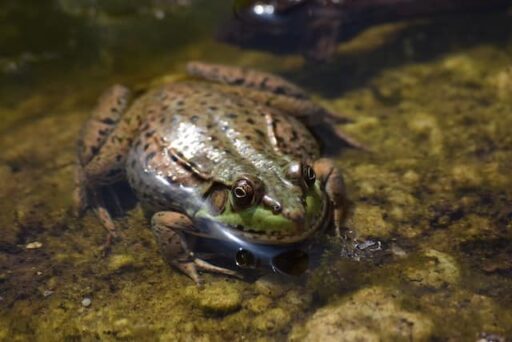
Pet lovers are often concerned about the dietary needs and preferences of their pets. Pet toads can eat the same food as wild toads.
Some pet owners don’t like to keep mice, insects, or small fish in their house. Therefore, they don’t add it to the toads’ diet. Due to this reason, pet toads’ diets remain limited to what the owners feed them or simply what the pet stores have for them.
Most people feed worms and crickets to their toad pets as they are readily available in most pet stores. Some pet owners cultivate food for their toads on their own. They should ideally feed them a variety of prey they would hunt themselves in nature.
If your pet toad is not native to the region where mice and small reptiles are accessible, you don’t have to provide them with such.
If you keep pet toads, we suggest you research the type of food that suits your toad species and what it actually likes to eat.
Walk around in your local pet store to see what you can find for your pet. Try to get something that your pet prefers to eat in the wilderness.
Alternatively, try giving them live prey to eat often. Eating live insects will eventually encourage them to hunt their prey themselves.
What Do Pet Toads Prefer Eating?
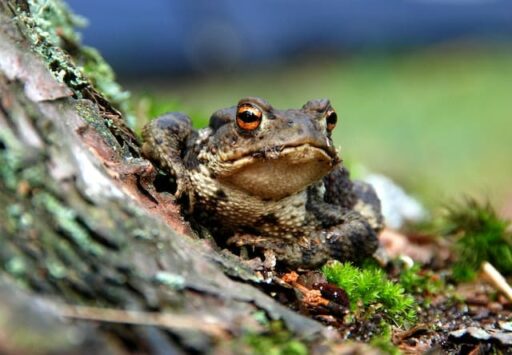
Some of the items pet toads prefer are:
- Earthworms
- Super worms
- Mealworms
- Crickets
- Feeder fishes
- Dubia roaches
How To Enhance Nutrition in Your Pet Toads’ Diet?
Pet toads primarily prefer live food. The best thing, in our opinion, that you can feed your pet toad is live crickets.
You can get them easily, as most pet stores raise crickets to feed amphibians and reptiles. However, these self or farm-raised crickets may not hold the same nutritious profile as wild crickets.
You can dust the crickets with vitamin and calcium supplements to increase their nutrition.
#1 UV Light Exposure
Make sure your toad hops around the sun absorbing ultraviolet B while catching those tiny insects and critters. UVB is essential for amphibians to break down calcium and vitamins and is highly beneficial for digestion.
Calcium is equally vital to ensure that your toad grows strong bones. If you don’t use supplements, your toad may face health issues.
#2 Water Intake
Give bottled water to your toad instead of tap water. Being amphibians, toads absorb water from their skin, and tap water may contain harmful chemicals, unhealthy additives, and strong metals that can make your toad become sick.
#3 Developing Eating Habits
Unlike wild species, pet toads recognize routine and prefer consistent feeding times. Also, they eat less than wild toads and can finish their meal within 15 minutes.
Therefore, you must feed your pet at the same time every day to form a routine. Moreover, try to remove the leftover food after your pet has had enough to prevent rotting and overeating.
What Food Can’t Toads Eat?
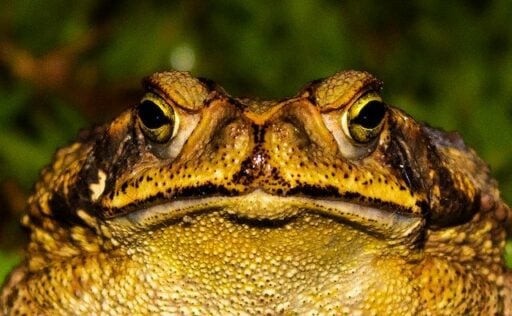
Toads have the tendency to eat anything given to them. However, this does not indicate that any type of food can be given to them without any check.
We have compiled a list of food items that are dangerous for your toads and must not be fed at any cost. Some of the foods you should always avoid for toads:
- Bread
- Salt
- Rice
- Seasoned Meat
- Processed Food
- Pesticides
- Sugar
- Expired Food
Toads are carnivores at heart, and their taste buds definitely lean toward live prey. They have little interest in dining on carrion or animals that have met their demise beforehand.
While they’re technically capable of munching on the occasional fruit or veggie, it’s safe to say it won’t exactly make them do a happy hop.
When it comes to feeding our warty friends, avoid the temptation to share your human meals, leftovers, or artificial concoctions. The salt and seasoning that we enjoy could wreak havoc on their sensitive digestive systems, leading to dehydration and other issues.
For a toad-friendly feast, opt for foods they’d naturally hunt in the wild, and don’t forget to sprinkle in those necessary supplements and vitamins to keep them hopping with health.
Can Toads Eat Human Food?
No, toads can’t eat human food generally. Toads are carnivores and prefer live-moving animals. In comparison, humans don’t eat live animals; rather, they like vegetables, fruits, and (cooked) dead animal meat. Never give a human diet to toads.
What Do Toads Drink and How?
Toads can drink water by absorbing the humidity present in their surroundings through their skin. This is an important factor why toads must live in a humid environment, as similar as possible to their natural habitat, to function properly.
Common Mistakes of Feeding Toads
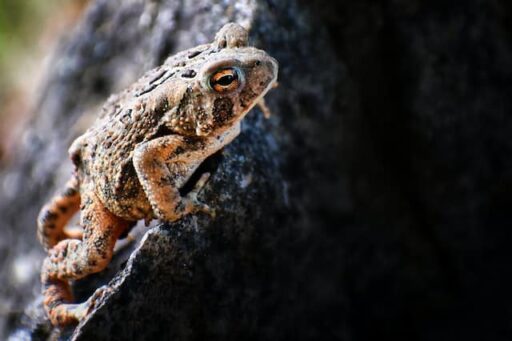
When feeding your toad, you must be careful about certain factors. Try to avoid these common mistakes to maintain the health of your beloved:
- Getting wild-caught insects found in the lawn can cause parasite infections.
- Offering dead insects which they won’t eat knowingly.
- Not adding extra supplements to the diet can cause deficiencies as the pet store food is low in nutritional value.
- Not providing food in the right quantity may result in over- or underfeeding.
- Giving a large-sized insect (cricket) to a Juvenile can lead to choking while trying to swallow.
Toad Feeding Tips
Toads love eating different varieties of food. You should make an effort to make your toad’s diet as interesting and exciting as possible.
We’ve listed some tips that will help you while feeding your toad:
- Similar Snack Size: While preparing toad-snacks, keep the size appropriate and consistent. Food that is too large for toads will be uncomfortable for them to swallow.
- Different Food Types: Add 4 to 6 foods to introduce some variety in the regular toad food.
- Hand-feeding Practice: You can feed your toad with your hands, but it needs patience and time.
- Water Accessibility: Always keep a water vessel near your toads at all times so that they can sit inside and soak through their skin.
- Familiar Food Groups: Get the food that your toads prefer eating, such as live crickets and worms, from the local pet shop.
The Bottom Line
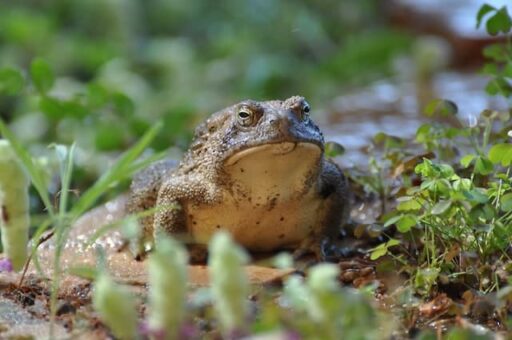
| Key Points |
| Toads are not baby frogs. |
| Toads have different diets in every life stage |
| Toads can choke on large sized food |
| Pet toads should be given supplements for better strength and growth |
| Care takers must include a variety of 4 to 6 types of foods in toad diet |
| Toads tend to eat anything that fits their mouth |
A toad is not just another name for a frog with a green body, four legs, and bold eyes. Toads have very different features and traits altogether.
In terms of diet, toads can eat almost anything it can fit in their mouth. After metamorphosis, toads become carnivores and start surviving on live insects and invertebrates like crickets, flies, worms, and spiders.
As they grow larger, they become capable of eating small mice, lizards, and other amphibians. Arrange the best diet for toads that meets their needs and personal preferences.
Whether you are a pet keeper or just an enthusiast, the information compiled in this article is helpful in all cases.
Give your toads unmeasurable love and care to watch them grow and thrive.
Thank you for reading this article! If you haven’t had enough of amphibian-facts yet, head over to read our post on Frog Poop.
Join our Forum for free today!


